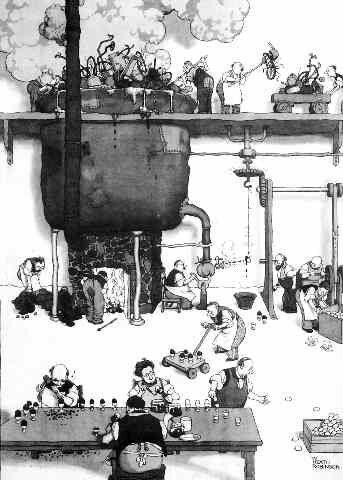Furthermore, I'm thinking of giving the gas turbines turbo-electric rather than direct-drive because the former aught to require less internal hull volume and flight deck area for the uptakes than the latter.
My point of departure for the development of gas turbines with turbo-electric drive is the Hotham trials. She was a Lend-Lease destroyer-escort with turbo-electric drive that the RN kept after World War II. The plan was to replace one of her two steam turbines with an English Electric EL60 gas turbine in order that a direct comparison of the steam and gas turbines could be made. But the development of the EL60 was abandoned in 1952 after the shore trials showed that the plant was overweight and not flexible enough for operation. They weren't cancelled in my "Version of History" because a suitable aircraft gas turbine was used instead of the EL60.
In other words, the Metrovick G.6.
Or to be more precise, hold off on the forced 1947 spin-off of Metropolitan-Vickers' aero engine business to Armstrong-Siddeley Motors.
MV had been working on an axial-jet aircraft engine (F.1 first run in April 1939 {a turboprop}, with a pure-jet F.2 version starting work in July 1940, then developed to a useful power with first flight on a Lancaster 29 June 1943 and flight of 2 F.2/1s in a Meteor on 13 November 1943. Work continued with improvements in reliability and thrust with the F.2/4 Beryl early 1944. Work then switched to the Sapphire until the Ministry of Supply ordered MV to cease work on aircraft engines in 1947, with the Sapphire being passed to ASM.
In 1943 MV had been granted a contract to begin development of a ship-propulsion GT, which led to the Gatric (based on the F.2), which produced 2,500 shp, and which was installed as a boost-propulsion system in M.G.B. 2009 in 1947. Continued development was slowed by the loss of the Sapphire design team, but by 1948 another order had been awarded for a more-powerful version for installation in 2 Bold class patrol vessels. The G.2 was a 4,500 shp engine, and shipboard testing began in 1951. Unfortunately, problems (some of which were fairly basic errors that the aero team would likely have have caught early on) slowed development of a production version.
MV continued work on a ship-drive version, resulting in the 7,500 shp G.6 (run in 1961 in Ashanti) which powered the County and Tribal classes for the RN and the San Giorgio and Alpino classes for Italy.
English Electric's venture with the E.L.60A starting in 1947 with first run in 1951, followed by a shipboard version (R.M.60, 5,400 shp) which was abandoned in 1955.
Both MV and EE had made their engines in a heavy frame and over-built components, and the RN's attention soon turned to adapting aero GTs for shipboard use (again, with MV keeping the Sapphire division this change could have been speeded up or the G series lightened significantly), and the heavy-frame marinized GTs were dropped.
Bristol-Siddeley (merger of ASM and Bristol) started work to adapt the Proteus aircraft shaft turbine to shipboard use in 1955, and by 1958 one was installed in Brave Swordsman, producing 4,250 shp.
BS then began work on a marinized Olympus producing 15,000 shp and up, which was installed in ships from 1966 on.
This document gives a synopsis of the development of maritime gas turbines, which I severely abridged for my text above.
However, it has one omission I feel compelled to mention. There is a statement therein which comments that while the USN was interested in the development of MGTs in the RN, it was not ready to start installing them in warships designed for them for a number of years after 1967.
What he neglects is the US Coast Guard's decision to jump right in, designing the Hamilton class of high-endurance cutters (the USCG's largest ships) for CODOG propulsion in the early 1960s.
The class was laid down from Jan. 1965 through April 1971, and commissioned into service from March 1967 through March 1972.
They had 2 × Fairbanks-Morse 38TD8-1/8-12 12-cylinder diesel engines generating 3,500 bhp each and 2 × Pratt & Whitney FT4A-6 gas turbines (derived from the J75 jet engine, and first run in 1964) producing 18,000 shp each for propulsion - and 2 × 550KW GM 8-645 diesel generators and 1 × 500KW Solar Model 101506-2001 gas generator for ship's power.
General Electric had also been working on maritime gas turbines, and in 1964 ran the LM1500 (13,300 shp, derived from the J79 jet engine). The LM2500 (based on the TF39, which was a turbofan development of the J79 jet engine) producing 25,000 shp ran in 1967.
Note that the modern LM2500 MGTs are derived from the CF6 turbofan, which was a development of the TF39.
Interestingly, The Federal Republic of Germany (West Germany) was also early in the game, with the Brown-Boveri maritime GT producing 13,000 shp by 1957.
Here is another interesting paper on the subject of MetroVick and gas turbines. It has an interesting title:
Jakob Whitfield
Metropolitan Vickers, the Gas Turbine, and the State: A Socio-Technical History, 1935-1960


